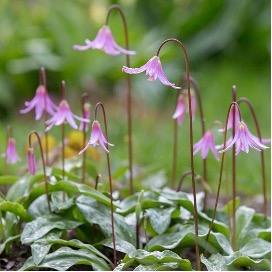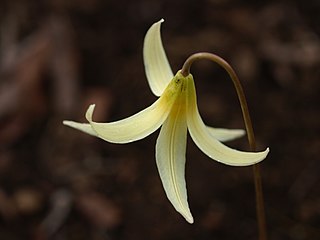How do I grow white and pink fawn lilies?
Pink Fawn Lily (Erythronium revolutum)

Erythronium, is a member of the lily family and is commonly known as the Western Trout Lily, Fawn Lily, Dog's-tooth Violet or Adder's Tongue. There are several species of Erythronium that are native to the west coast of North America from coastal northern California to British Columbia including Vancouver Island. Vancouver Island is known to have some particularly good and protected areas where these plants grow abundantly. Some habitats are threatened in the wild by collection for horticulture and soil compaction by forest machinery. If gathering from the wild it is essential to only gather a few seeds and leave plenty to germinate in the wild. Never disturb the bulbs from where they grow naturally.
Pink Fawn Lily is a bulbous herbaceous perennial growing from an oval-shaped bulb 1-2 inches (3- 5cms) long, hence the name dog-toothed violet. The name Trout Lily reflects the dark brown mottling on the leaves. It grows about 12inches (30cms) tall with pairs of long, thick, white-spotted leaves growing from the base. The leaves emerge in springtime and grow to 6-8inches (20-25cm) tall and then in the late spring/early summer each bulb sends up a long stalk bearing one or more star-shaped flowers. The stalk bends at the end so that the face of the flower points to the ground. There are six tepals (fused petals and sepals) in shades of pink or light purple which may have yellow or white spotting toward the centre of the flower. The tepals may be straight or recurved. They tend to curve further as the flower ages. The anthers are bright yellow and are a nice contrast to the pink open-faced flowers. Once the tepals die back the seed head ripens into long capsules full of tiny black seeds.
Erythronium revolutum grows in moist understory areas with mixed conifer and deciduous trees. It requires some shade and humus-rich soil that does not dry out and remains damp (not wet) in spring. This is a slow growing plant taking 5 – 7 years to form a flowering size bulb from seed, and therefore is slow to establish in new locations but bulbs can be purchased ready to plant. The bulbs are quite delicate and should be planted at a depth of approximately 4inches (10cms) and benefit from a layer of leaves as a mulch. They will naturalise given time and the right growing conditions. The plant is deer resistant.
The cultivar var. johnstonii has been awarded an Award of Garden Merit by the British Royal Horticultural Society).
White Fawn Lily (Erythronium oregonum)

The White Fawn Lily, Giant White Fawn lily or Oregon Fawn Lily are all common names of Erythronium oregonum. It is a perennial herb native to southern BC including Vancouver Island and all the way south down the western coastal areas to northern California, growing in meadows, rocky outcrops, and coniferous forests.
The bulb is narrowly egg-shaped and 1-2 inches (3-5cm) long and should be planted at a depth of about four inches (10cms). The two leaves emerge from the ground in early spring and are dark green mottled with brown and white or pale green. The flower stems follow in mid to late spring and are leafless and unbranched. The 16-18 inch (40-46cm) stems bear a single creamy white flower or sometimes two or three. The flowers are white with some yellow or orange at the base on the inner surface and have six distinct tepals. Once the sepals die back the seed head is 1-3 chambered and carries anywhere from just a few to very many seeds. By late spring/early summer the entire plant goes dormant.
This Fawn Lily, just like the pink Fawn Lily, is pollinated by native bumble bees, butterflies, moths and hummingbird and thrives in partial shade. It too prefers a well-drained, moisture retentive soil, rich in humus with abundant leaf litter and organic matter. The bulbs should be planted at a depth of about four inches (10cms) and mulched with leaves. The plant can survive drought conditions more readily than conditions that are too wet. It is a delightful, low maintenance, woodland or native garden flower and, because it dies back and all but disappears in the summer, it is a good idea to plant other flora around it such as Camas, Sword Fern and Oceanspray to give year-round interest. The plant is deer resistant.
As with the pink Fawn Lily, some habitats are threatened in the wild by collection for horticulture and soil compaction by forest machinery. If gathering from the wild it is essential to only gather a few seeds and leave plenty to germinate in the wild. Never disturb the bulbs from where they grow naturally.
Erythronium oregonum flower
Sources:
https://sierraclub.bc.ca/pink-fawn-lily/
https://linnet.geog.ubc.ca/Atlas/Atlas.aspx?sciname=Erythronium%20oregonum&redblue=Both&lifeform=7
https://linnet.geog.ubc.ca/Atlas/Atlas.aspx?sciname=Erythronium%20revolutum&redblue=Both&lifeform=7
my own garden!
Return to:
Perennials page
You Asked Us page
Victoria Chapter page